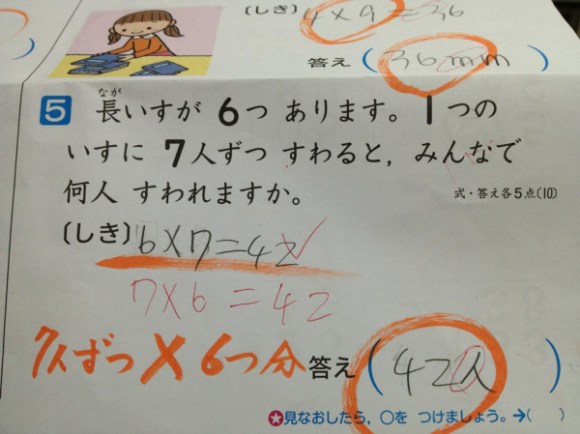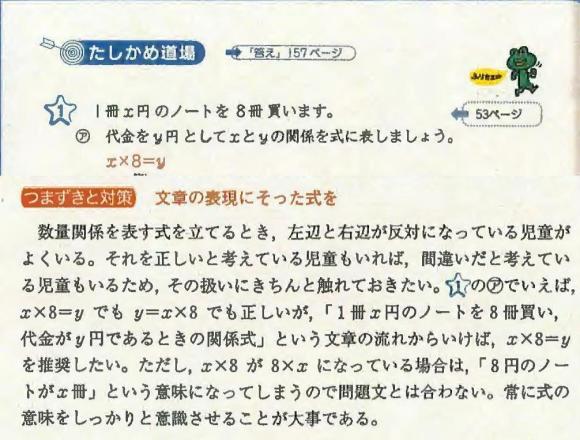 Here’s an elementary school math question for you all:
Here’s an elementary school math question for you all:
Apples are sold for 100 yen each. If you buy 5 what is the total amount?
If you said “5 × 100 = 500” then I’m sorry but you just flunked second grade math in Japan… if there were only one question all year.
The reason is an old teaching method that is employed in elementary and middle schools throughout the country. It’s also a method that many, such as a blogger by the name of Uncorrelated, want stopped as it leads to strange logic where six times seven does not always equal 42 and five times 100 might not equal 500.
It’s almost an annual event around the internet as someone’s young child with hope for a brighter future comes home with red pen all over their “correctly done” test or homework.
Let’s start with a typical example from twitter. This photo was tweeted with the caption: “My co-worker’s son’s grade two math test was returned but I can’t understand why he got this wrong…”
The question reads, “There are six couches. Seven people sit on each couch, so how many people are sitting all together?” As we can see, the child showed his work using the seven times tables (my least favorite of them all) and put the answer as “42 people” even remembering the units.
However, the teacher has corrected the child’s mistake of “6 × 7 = 42” with the much more correct “7 × 6 = 42” explaining that it’s “seven people times six seats” not the other way around!
The following photo has been well circulated around the internet and appears to show a question from a teacher’s guide along with an explanation of the answer.
The question and given answer read:
1) There are x-yen notebooks 8 of which are bought.
A: If y-yen is the total price, write a formula to express the relation between x and y.
x × 8 = y
Then there is an explanation of this question for the teacher’s reference which says:
When making a formula that expresses a quantity relationship, children often reverse the left and right hand sides. If children are taught this is okay, then the children are being taught wrong, so you want to address this awkwardness properly. In terms of question 1-A; x × 8 = y or y = x × 8 is correct. If you follow the flow of the text “x-yen notebooks, eight of which are being bought; the formula when the price is y yen” you should say x × 8 = y. However in the case that x × 8 becomes 8 × x the meaning becomes “8-yen notebooks, x of which are being bought” and is not the same as this problem. It is always important to firmly make them aware of the formula’s meaning.
Some, including Uncorrelated, question whether this is an authentic teacher’s manual especially due to the final sentence referring to the formula having “meaning” which the writers seemed to have just invented. Uncorrelated argues that this logic flies in the face of commutative properties which are taught shortly after in the school system. Commutative properties compare the functions of addition and multiplication to achieve the same result such as 2 × 3 = 3 × 2 = 2 + 1 + 3 = 3 + 2 + 1.
Taking this one step further, Uncorrelated points out that the formula seems based on the wording of the question which itself can be rearranged more than one way. In fact, if we use a more natural English translation of the question: “8 x-yen notebooks are being bought” this would suggest that 8 × x = y is the “only” correct answer that matches the question. This would render an “important rule” to be completely arbitrary and kind of absurd.
On the other hand, there is something to be said for the clarity of a unified format for expressing formulas and values. It’s one thing to have a genius idea but it’s equally important to have others understand it as well. If I went shopping and the clerk told me my pack of chewing gum cost about 0.025 mL of crude oil from Saudi Arabia, I’d be quite annoyed.
However, I would also be quite impressed at the clerk’s creativity, and that’s what children should be encouraged to have at such a young age. Rather than drilling useless dogma with regards to math, they should be allowed to see numbers in their own way with just enough guidance to help them through. That tends to be when greatness happens.
Source: Blogos – Uncorrelated via Hachima Kiko (Japanese)
Images: Wikipedia – Abrahami, Twitpic – string spirits, Twitter – genkuroki



 Japanese elementary school kid says 12 x 25 = 300, teacher doesn’t say he’s answered correctly
Japanese elementary school kid says 12 x 25 = 300, teacher doesn’t say he’s answered correctly Student penalized for writing the number “4” the “wrong” way on worksheet
Student penalized for writing the number “4” the “wrong” way on worksheet Spy x Family anime cafe opening, non-secret agents welcome too
Spy x Family anime cafe opening, non-secret agents welcome too Japanese elementary school student teaches us how to solve a difficult maths problem
Japanese elementary school student teaches us how to solve a difficult maths problem Do try this at home! 5 foods that you can recreate in taste by combining other foods
Do try this at home! 5 foods that you can recreate in taste by combining other foods McDonald’s new Happy Meals offer up cute and practical Sanrio lifestyle goods
McDonald’s new Happy Meals offer up cute and practical Sanrio lifestyle goods All-you-can-drink Starbucks and amazing views part of Tokyo’s new 170 meter-high sky lounge
All-you-can-drink Starbucks and amazing views part of Tokyo’s new 170 meter-high sky lounge Studio Ghibli glasses cases let anime characters keep an eye on your spectacles
Studio Ghibli glasses cases let anime characters keep an eye on your spectacles More foreign tourists than ever before in history visited Japan last month
More foreign tourists than ever before in history visited Japan last month Starbucks reopens at Shibuya Scramble Crossing with new look and design concept
Starbucks reopens at Shibuya Scramble Crossing with new look and design concept Beautiful Sailor Moon manhole cover coasters being given out for free by Tokyo tourist center
Beautiful Sailor Moon manhole cover coasters being given out for free by Tokyo tourist center The oldest tunnel in Japan is believed to be haunted, and strange things happen when we go there
The oldest tunnel in Japan is believed to be haunted, and strange things happen when we go there The best Japanese curry in Japan isn’t eaten at a restaurant
The best Japanese curry in Japan isn’t eaten at a restaurant Is the new Shinkansen Train Desk ticket worth it?
Is the new Shinkansen Train Desk ticket worth it? Mister Donut ready to make hojicha dreams come true in latest collab with Kyoto tea merchant
Mister Donut ready to make hojicha dreams come true in latest collab with Kyoto tea merchant Disney princesses get official manga makeovers for Manga Princess Cafe opening in Tokyo
Disney princesses get official manga makeovers for Manga Princess Cafe opening in Tokyo We try out “Chan Ramen”, an underground type of ramen popular in the ramen community
We try out “Chan Ramen”, an underground type of ramen popular in the ramen community Beautiful new Final Fantasy T-shirt collection on the way from Uniqlo【Photos】
Beautiful new Final Fantasy T-shirt collection on the way from Uniqlo【Photos】 Foreign English teachers in Japan pick their favorite Japanese-language phrases【Survey】
Foreign English teachers in Japan pick their favorite Japanese-language phrases【Survey】 There’s a park inside Japan where you can also see Japan inside the park
There’s a park inside Japan where you can also see Japan inside the park Japanese convenience store packs a whole bento into an onigiri rice ball
Japanese convenience store packs a whole bento into an onigiri rice ball Studio Ghibli releases Kiki’s Delivery Service chocolate cake pouches in Japan
Studio Ghibli releases Kiki’s Delivery Service chocolate cake pouches in Japan Japan’s bone-breaking and record-breaking roller coaster is permanently shutting down
Japan’s bone-breaking and record-breaking roller coaster is permanently shutting down New definition of “Japanese whiskey” goes into effect to prevent fakes from fooling overseas buyers
New definition of “Japanese whiskey” goes into effect to prevent fakes from fooling overseas buyers Foreign passenger shoves conductor on one of the last full runs for Japan’s Thunderbird train
Foreign passenger shoves conductor on one of the last full runs for Japan’s Thunderbird train Our Japanese reporter visits Costco in the U.S., finds super American and very Japanese things
Our Japanese reporter visits Costco in the U.S., finds super American and very Japanese things Kyoto bans tourists from geisha alleys in Gion, with fines for those who don’t follow rules
Kyoto bans tourists from geisha alleys in Gion, with fines for those who don’t follow rules Studio Ghibli unveils Mother’s Day gift set that captures the love in My Neighbour Totoro
Studio Ghibli unveils Mother’s Day gift set that captures the love in My Neighbour Totoro Domino’s Japan now sells…pizza ears?
Domino’s Japan now sells…pizza ears? New Japanese KitKat flavour stars Sanrio characters, including Hello Kitty
New Japanese KitKat flavour stars Sanrio characters, including Hello Kitty Sales of Japan’s most convenient train ticket/shopping payment cards suspended indefinitely
Sales of Japan’s most convenient train ticket/shopping payment cards suspended indefinitely Sold-out Studio Ghibli desktop humidifiers are back so Totoro can help you through the dry season
Sold-out Studio Ghibli desktop humidifiers are back so Totoro can help you through the dry season Japanese government to make first change to romanization spelling rules since the 1950s
Japanese government to make first change to romanization spelling rules since the 1950s Ghibli founders Toshio Suzuki and Hayao Miyazaki contribute to Japanese whisky Totoro label design
Ghibli founders Toshio Suzuki and Hayao Miyazaki contribute to Japanese whisky Totoro label design Doraemon found buried at sea as scene from 1993 anime becomes real life【Photos】
Doraemon found buried at sea as scene from 1993 anime becomes real life【Photos】 Tokyo’s most famous Starbucks is closed
Tokyo’s most famous Starbucks is closed One Piece characters’ nationalities revealed, but fans have mixed opinions
One Piece characters’ nationalities revealed, but fans have mixed opinions We asked a Uniqlo employee what four things we should buy and their suggestions didn’t disappoint
We asked a Uniqlo employee what four things we should buy and their suggestions didn’t disappoint Princesses, fruits, and blacksmiths: Study reveals the 30 most unusual family names in Japan
Princesses, fruits, and blacksmiths: Study reveals the 30 most unusual family names in Japan Studio Ghibli’s new desktop Howl’s Moving Castle will take your stationery on an adventure
Studio Ghibli’s new desktop Howl’s Moving Castle will take your stationery on an adventure Sesame Street Fighter, the most badass children’s TV show ever (if only there were a show for it)
Sesame Street Fighter, the most badass children’s TV show ever (if only there were a show for it) Akihabara Radio Kaikan’s gacha capsule toy lucky bag is an otaku delight【Photos】
Akihabara Radio Kaikan’s gacha capsule toy lucky bag is an otaku delight【Photos】 Anime figurines rejoice as fully working miniature locker appears on gacha market
Anime figurines rejoice as fully working miniature locker appears on gacha market Up, up, down, down, left, right, left, right, B, A pop-up cafe to open in Akihabara
Up, up, down, down, left, right, left, right, B, A pop-up cafe to open in Akihabara New school in Iraq to provide a Japanese-style education
New school in Iraq to provide a Japanese-style education Uncle and netizens confused about child’s low grade on math assignment
Uncle and netizens confused about child’s low grade on math assignment Boys’ love manga categorized into more than 30 sub-genres at mainstream Tokyo bookstore
Boys’ love manga categorized into more than 30 sub-genres at mainstream Tokyo bookstore “A dead bug” and other amusing, adorable, snarky, and downright ridiculous test responses
“A dead bug” and other amusing, adorable, snarky, and downright ridiculous test responses Reebok teams up with fashion brand Yoshiokubo for traditional-culture-inspired sneakers
Reebok teams up with fashion brand Yoshiokubo for traditional-culture-inspired sneakers Ichiran ramen fukubukuro lucky bag comes with big and small surprises
Ichiran ramen fukubukuro lucky bag comes with big and small surprises Learn Japanese schoolgirl vocabulary with new video from Line【Video】
Learn Japanese schoolgirl vocabulary with new video from Line【Video】 Flexible teachers DO exist in Japan: First-grader gets full credit for “wrong” math test answers
Flexible teachers DO exist in Japan: First-grader gets full credit for “wrong” math test answers Best doughnuts in Tokyo? Sweet floral creations cause a stir on social media
Best doughnuts in Tokyo? Sweet floral creations cause a stir on social media Sleep in a bookshelf at the new bookstore-themed hostel in Kyoto
Sleep in a bookshelf at the new bookstore-themed hostel in Kyoto Meowrse code: when you want to send an SOS filled with cute cats
Meowrse code: when you want to send an SOS filled with cute cats Foreign English teacher in Japan calls student’s ability garbage, says it was an “American joke”
Foreign English teacher in Japan calls student’s ability garbage, says it was an “American joke”
Leave a Reply